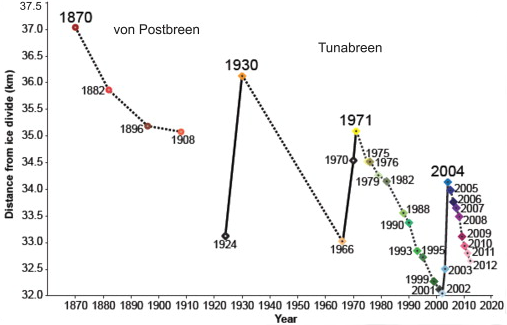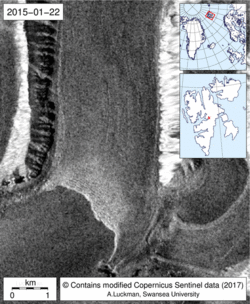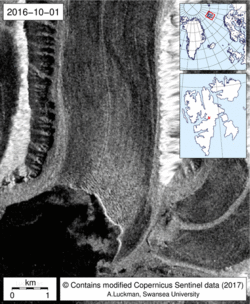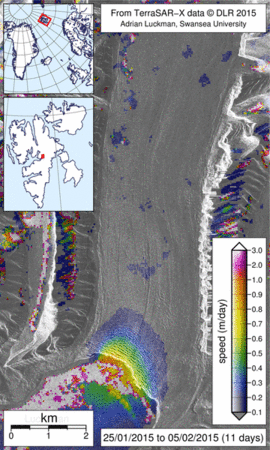Unexpected ‘surge’ of a Svalbard tidewater glacier
Most Svalbard surges are unexpected. After decades of inactivity, Svalbard glaciers can suddenly pick up speed and transform a smooth, safe snowmobile or skiing route into a fast-flowing, chaotic maze of ice pinnacles and crevasses. But if there was one Svalbard glacier we expected NOT to surge, it is Tunabreen, a tidewater glacier that flows into Tempelfjorden some 45 km NE of the main settlement of Longyearbyen. Tunabreen is one of the few glaciers in the archipelago known to have surged three times, around 1930, in 1970/71 and in 2003/04, indicating a regular 40 year cycle.

After the well-documented surge of 2003/04, we expected that the glacier would retreat up-fjord for decades, perhaps reawakening only in 2045. But new observations made by Professor Adrian Luckman (Department of Geography, Swansea University and the Department of Arctic Geophysics, University Centre in Svalbard) show that Tunabreen is not playing by the rules. As part of the ConocoPhillips-Lundin funded CRIOS project (Calving Rates and Impact on Sea Level) led by Professor Doug Benn, Luckman has been processing imagery from the TerraSAR-X satellite, deriving regular velocity maps and measuring rates of iceberg calving. Tunabreen was one of the target glaciers in that study, reported by Luckman et al. (2015).


Since our detailed observations began in 2013, the glacier has shown a regular annual cycle of activity, with a speed-up near the ice front each summer followed by near-inactivity during the winter. That pattern changed in late 2016, when instead of the usual slowdown the glacier accelerated to speeds of over 2 metres per day. Moreover, the speedup was not confined to the frontal zone, but spread over 7 km upglacier over the following months. The lower glacier is now fissured with deep crevasses, making areas that were previously safe extremely hazardous. The cause of this unusual behaviour is not yet known, but it may be a reaction to the unusually high air temperatures and heavy rain in the autumn of 2016. The glacier is showing no signs of slowing down, and we wait to see what will happen next, especially when the summer melt begins in May or June. Whatever happens, it is clear that Tunabreen will retain its ability to surprise us!

